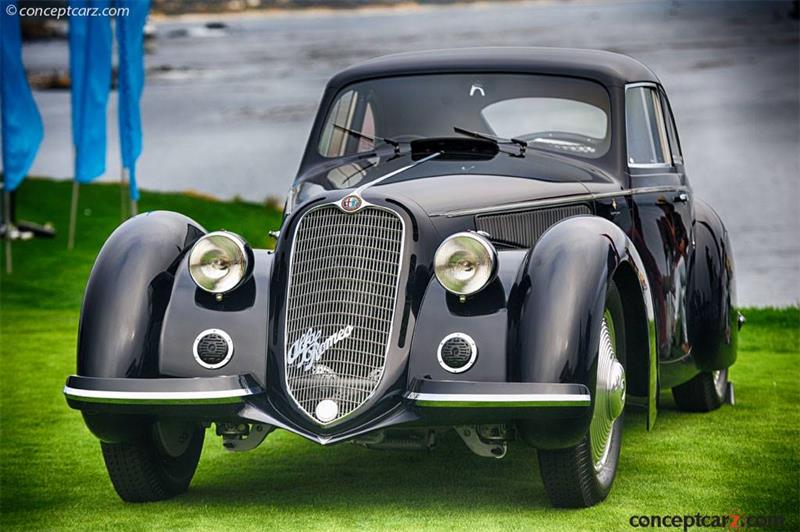Evolving from the successful 1936 8C 2900A, the 2900B is the highly cultured son of the grand champion athlete. Hidden under the long and graceful hood lives an engine with a racing heritage. The 2900 cc straight eight-cylinder supercharged masterpiece features dual camshafts, dual magnetos and dry-sump oiling. Despite reduced compression compared to 2900A, it still produces an astounding 180 horsepower, delivered through a four-speed gearbox.
Lungo Berlinetta by Touring
Chassis #: 412020
View info and historyTwo of Italy's finest designers provided appropriate coachwork for the 2900B, Carrozzeria Touring and Stabilimenti Farina, and each is somewhat unique.An automotive jewel engineered by Vittorio Jano, the 8C 2900 was designed to compete in sports car races, especially the Mille Miglia, which it won outright in 1935, 1936, 1937, 1938 and 1947. In racing trim, they dominated all the major competitions, and in road trim, they were the fastest grand touring cars.Established in 1925 in Milan, Italy coachbuilder Carrozzeria Touring had first licensed Charles Weymann's system of fabric-covered lightweight frames and then developed its own 'Superleggera' construction. Patented in 1936, the Superleggera system consists of a structural framework of small-diameter steel tubes that conform to an automobile body's shape and are covered by thin alloy body panels that strengthen the framework.
Spider by Touring
View info and historyWith Auto-Union and Mercedes-Benz's entry into Grand Prix racing in 1934, the level of racing quickly escalated, and it was soon apparent that suspension by rigid axles on semi- or quarter-elliptic springs was outdated. The 8C2300 sports cars and the Grand Prix Tipo B had served Alfa Romeo admirably, but now it was time for a new design philosophy and a complete revision. To hasten the process, Alfa Romeo contracted with the Porsche design office who had been responsible for the design of the Auto Union. The resulting design incorporated an all-new independent suspension system for the 6C2300B (Project number 63) and the 8C2900 (Project number 69). Working in conjunction, the Alfa Romeo technical department was working on a new rigid frame that was much different than the previous flexible units. In 1934, Alfa Romeo introduced the 6C2300 as a replacement for the earlier six-cylinder models and featured chain-driven overhead camshafts rather than gear-driven ones. They did, however, continue to utilize their predecessor's semi-elliptic springs. That changed in 1935 when the use of the all-independent chassis began, complete with double trailing arms with enclosed spring/damper units at the front and torsion bars at the rear. Retaining the predecessor's engine and gearbox, the updated suspension brought about a new name of 6C2300B. A similar front suspension setup of the 6C2300B was used on the successor to the 8C2300, but the rear setup was completely different. The gearbox was built in unit with the back axle, swing axles, radius arms with the middle supported by a transverse leaf spring. On either side were a pair of shock absorbers, with one hydraulic and the other an adjustable friction type. Early cars had a cable used for adjustment, while later cars were hydraulic. The early 8C2900 sports cars, along with the new Tipo C Grand Prix cars, used horizontal spring/damper units at the front which was changed to vertical by 1936. The Tipo C Grand Prix cars were first raced in the Italian Grand Prix in September 1935 and used a similar suspension design as the 8C2900. 
Cabriolet by Pininfarina
Chassis #: 412012
Engine #: 422008
View info and historyThe engine powering the 8C2900 was essentially a development of the Grand Prix Tipo B power unit, with fixed head and block units, twin superchargers, magneto ignition, and twin updraft Weber carburetors. The 8C2900A had a 2.75-meter wheelbase, and some 8C2900A models were sold as 8C2900Bs but retained the 2.75-meter wheelbase. The standard 8C2900B models had a slightly longer wheelbase of 2.8 meters for the Corto (short chassis) and 3.00 meters for the lungo (long chassis). The supercharged engines powering the 8C2900B was a detuned version of the 8C2900A with more aluminum castings compared to the magnesium ones on the race cars.In October of 1935, at the Paris Salon, Alfa Romeo introduced the 8C2900A, with the open spider body coachwork courtesy of Carrozzeria Alfa and painted in two different colors separated by a curved line along the side. While it was traditional for the era, the body wore no louvers in the bonnet, however, there were a series of small openable vents down each side. Later in the year, a second car with a similar design was shown at the Milan show. While sports cars and Grand Prix cars remained important to Alfa Romeo, the company's resources were limited as much of the labor and talent were spent supporting the Italian war effort in Africa with aero engines, trucks, and various other military equipment. In fact, Alfa Romeo made very few cars in 1936. They did send four cars to Scuderia Ferrari with similar lightweight bodies as the Tipo C Grand Prix car but with cycle wings and lights added called botticellas. In this guise, they finished first, second, and third at the Mille Miglia and won the Spa 24 hours. Scuderia Ferrari finished first and second in the 1937 Mille Miglia, and their final appearance as the works racing team was in October of that year when Pietro Ghersi won the Pontedecimo-Giovi Hillclimb. The racing program shifted from Scuderia Ferrari in Modena to the new Alfa Corse facility at Portello in Milan. In preparation for the 1938 season, five new spiders were built with coachwork by Touring. At the 1938 Mille Miglia, they finished 1st and 2nd. Works entries also won the Spa 24 hour race in Belgium as well as several hillclimbs. A one-off Berlinetta was built for the 1938 24 hour race at Le Mans. It was a contender for overall victory but was eventually retired due to a blow front tire that exploded with such force that the shredded tire cut through the bodywork. 
Lungo Berlinetta by Touring
Chassis #: 412020
View info and historyBy the close of 1936, Alfa Romeo displayed a Carrozzeria Alfa spider at the Paris Salon wearing a similar paint design scheme as the 1935 Milan show car. That same car was shown at the 1936 Milan show but was alternated with another spider with white central bodywork and red wings. Another example - also with spider coachwork - was painted with a single dark color and was shown at the Berlin and Geneva show in the early part of 1937.One example of the 8C2900A model was sold with the Mille Miglia style body to an Argentinian customer. The other examples wore Carrozzeria Alfa bodywork and two original examples survive in modern times, but both with firewall plates identifying them as 8C2900B. Around this time, Carrozzeria Touring produced two new designs with drawing numbers 977 for a coupe on a long chassis and 979 for a spider on a short chassis, the latter specifically built for an American client MacLure Halley. The first spider built on a short chassis may have been chassis number 412011 that was shown at the London Motor Show from October 14th to 23rd of 1937. The first coupe or Berlinetta was chassis number 412020 and it was shown in Paris from October 7th to the 17th. From October 28th to November 8th, both the Berlinetta and the Maclure Halley car (412014) were on display at the Milan Show. 412011 and 412020 were both exhibited at the Berlin show in early 1938 and sold to German customers.
Lungo Berlinetta by Touring
Chassis #: 412020
View info and historyFour additional short chassis spiders were built with Touring chassis after the first two examples (412011 and 412014). They then switched to building spiders on the long chassis. Although they had open coachwork, they were heavier than the Berlinetta's due to the use of steel in the bodywork compared to aluminum in the Berlinettas. Production of the long chassis spiders continued into 1939 with chassis number 412042 being sold in August 1939. During the early part of the war, two additional cars were completed including a Carrozzeria Touring saloon for the King of Romania and one an experimental streamlined spider built by Alfa Romeo.Five Carrozzeria Touring Berlinettas were built including 412020, 412024, 412029, 412035 and 412036. The cars built between 212029 and 412035 were works sports-racing cars of 1938. There were slight differences between the five Touring Berlinettas. The first example had a steeper rake to the angle of the radiator grille than the other cars. Chassis number 412024 had a smaller windscreen than the other cars; at some point 412029 gained a fabric sliding roof, and 412035 and 412036 wore slightly longer running boards than 412024.
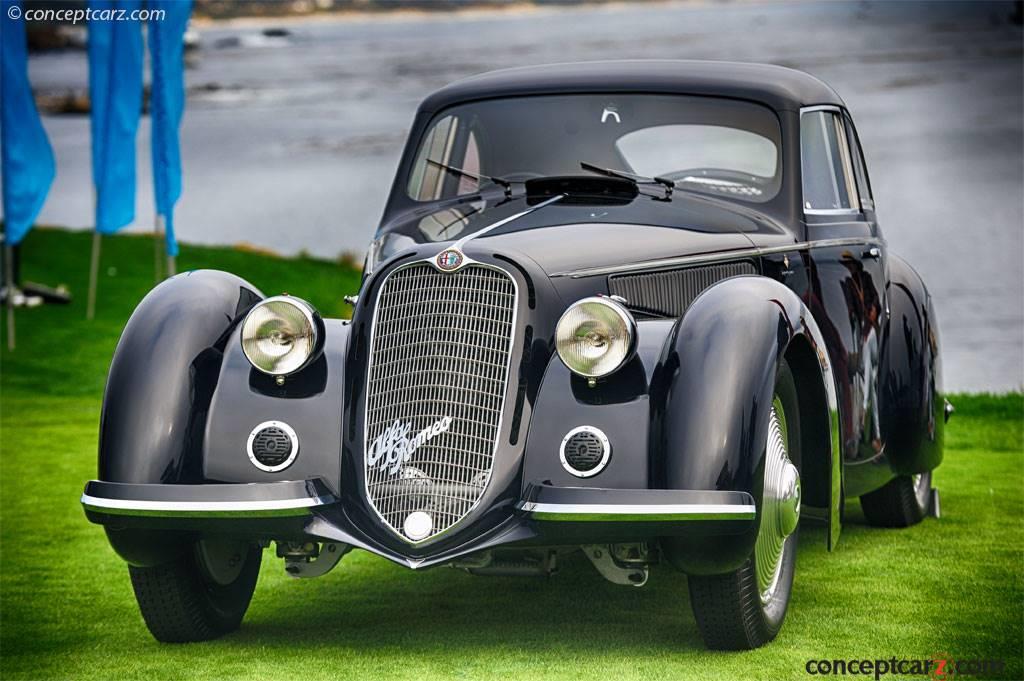
Lungo Berlinetta by Touring
Chassis #: 412020
View info and history
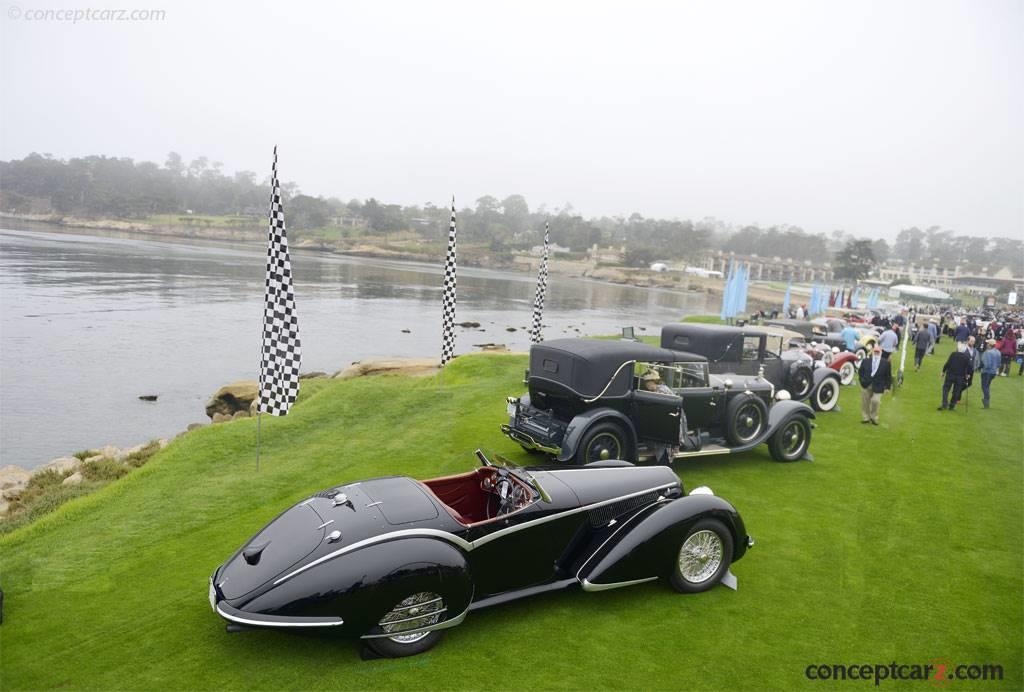
Spider by Touring
View info and history
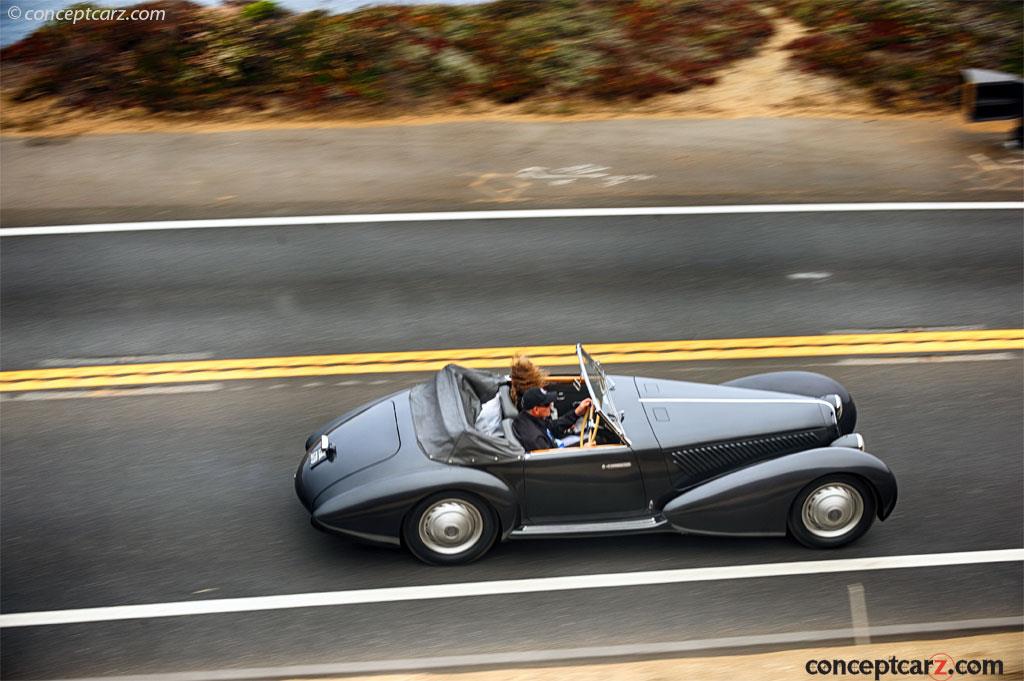
Cabriolet by Pininfarina
Chassis #: 412012
Engine #: 422008
View info and history
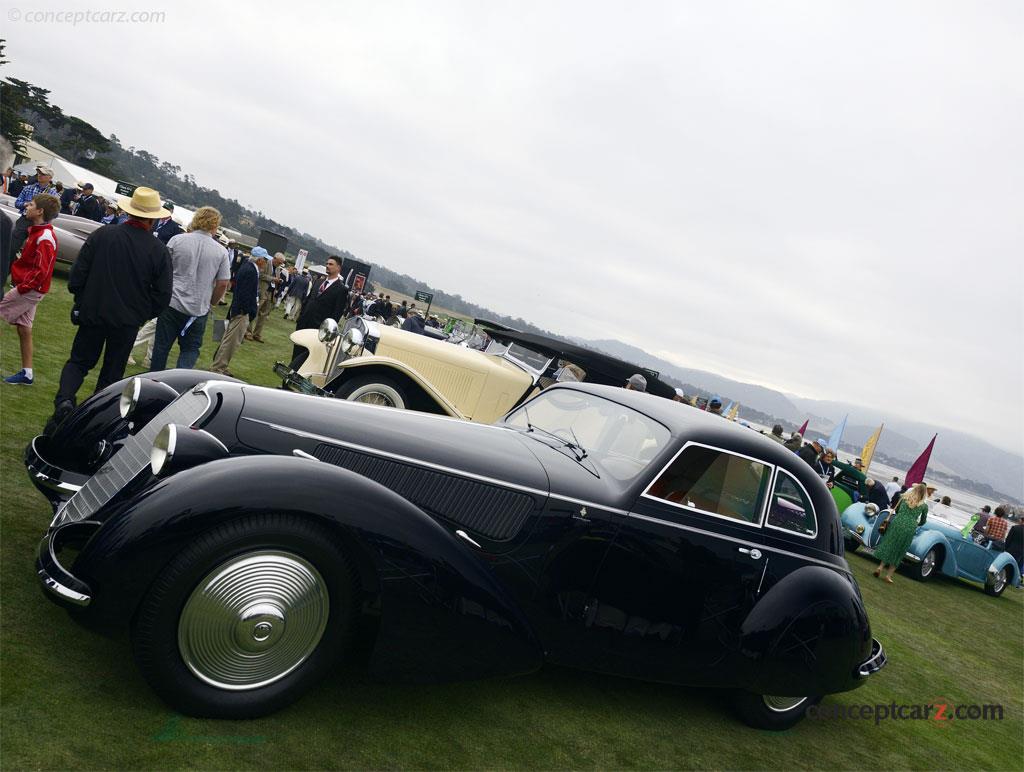
Lungo Berlinetta by Touring
Chassis #: 412020
View info and history
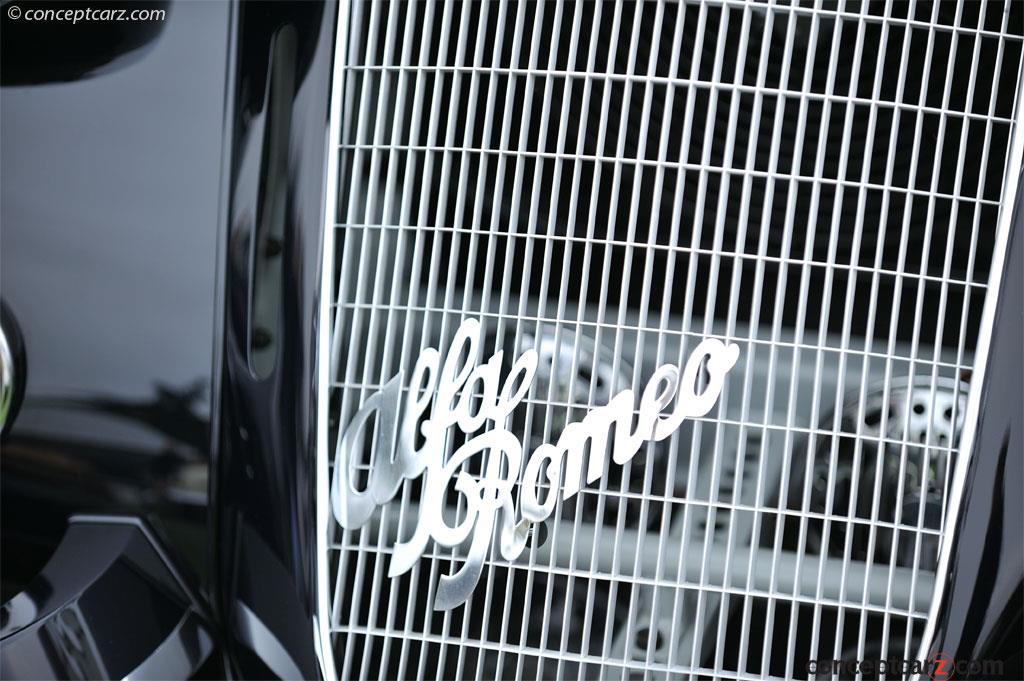
Lungo Berlinetta by Touring
Chassis #: 412020
View info and history
Related Reading : Alfa Romeo 8C History
Vittorio Jano was responsible for the design of the magnificent engineering marvel, the 8C 2300. The name was formed by following Alfa Romeos naming convention the 8C represented the eight-cylinder engine while the 2300 represented the cubic-capacity. The engine is comprised of two four-cylinder engines with the cylinders aligned in a row. Central gearing drives the overhead twin camshafts. A Roots-type....
Continue Reading >>
Continue Reading >>
Similarly Sized Vehicles
from 1937
Alfa Romeo Monthly Sales Volume
March 2023
2,390
1937 Alfa Romeo 8C 2900B Vehicle Profiles
Recent Vehicle Additions
Related Automotive News

1937 Alfa Romeo 8C 2900 B Celebrated as Best of Show at 27th Annual Greenwich Concours d'Elegance
A 1937 Alfa Romeo 8C 2900 B was chosen as this years Best of Show at the 27th annual Greenwich Concours dElegance. The winner at Saturdays inaugural Concours de Sport was a 1965 Ford GT40 Mk I. The 2023 event further established the weekends focus...

Alfa Romeo Named Best of Show at the 68th Pebble Beach Concours d'Elegance
Touring-Bodied Alfa Romeo 8C 2900B Named Best of Show at the 68th Pebble Beach Concours dElegance
PEBBLE BEACH, Calif. (August 26, 2018) — After an intense competition that drew diverse cars from around the globe, the coveted gold Best of Show...

Past Best of Show Winners at The Pebble Beach Concours d'Elegance
overview1
The 70th anniversary of the Pebble Beach Concours dElegance was celebrated with a spectacular display of previous Best of Show winners. Thirty-seven examples graced the showfield and many were still with the same owners who raised the trophy...

2019 Pebble Beach Concours d'Elegance Best of Show Winner
1931 Bentley 8 Litre Named Best of Show at the 69th Pebble Beach Concours dElegance
PEBBLE BEACH, Calif. (August 18, 2019) — Every August, the history of the automobile rolls onto the competition field of the Pebble Beach Concours dElegance...

Alfa Romeo Named Best of Show at the 68th Pebble Beach Concours d'Elegance
Touring-Bodied Alfa Romeo 8C 2900B Named Best of Show at the 68th Pebble Beach Concours dElegance
PEBBLE BEACH, Calif. (August 26, 2018) — After an intense competition that drew diverse cars from around the globe, the coveted gold Best of Show...

Maserati Granturismo 'Special Edition' And Levante Ermenegildo Zegna Show Car Debuts At Geneva International Motor Show
Maserati GranTurismo and GranCabrio celebrates the 60th anniversary of the 3500 GT, the very first GT car that segmented the market in 1957, with a Special Edition the production run will be limited to 400 units.
The SUV Levante Show Car, fe...

1938 Alfa Romeo 8C 2900B Touring Spyder Epitomizes The Elegance at Hershey
HERSHEY, PA - The theme for this years Elegance at Hershey is Celebration of Speed. After deciding upon the overall theme, One of the first decisions we made was to choose an automobile that epitomized that concept, stated Steve Moskowitz,...
























